AM905001 Cross-Cultural Management: Kawerau Dairy Case Study Report
VerifiedAdded on 2023/04/24
|20
|4800
|317
Report
AI Summary
This report provides an in-depth analysis of cross-cultural management challenges faced by Kawerau Dairy, a collaboration between a Maori iwi organization in New Zealand and a Japanese dairy unit. The study explores the impact of cultural dimensions, such as power distance and long-term orientation, on decision-making processes. It examines the significance of cultural factors like low-context versus high-context communication, Confucianism, and traditional values, and their influence on organizational dynamics. The report also evaluates Mana enhancing management practices and strategies for effective participation within a multicultural team, offering recommendations to improve cross-cultural interactions and overall organizational success. The analysis utilizes Hofstede's cultural dimensions theory to compare the cultural values of New Zealand and Japan, providing examples and insights into the complexities of managing a diverse workforce and navigating international business operations.
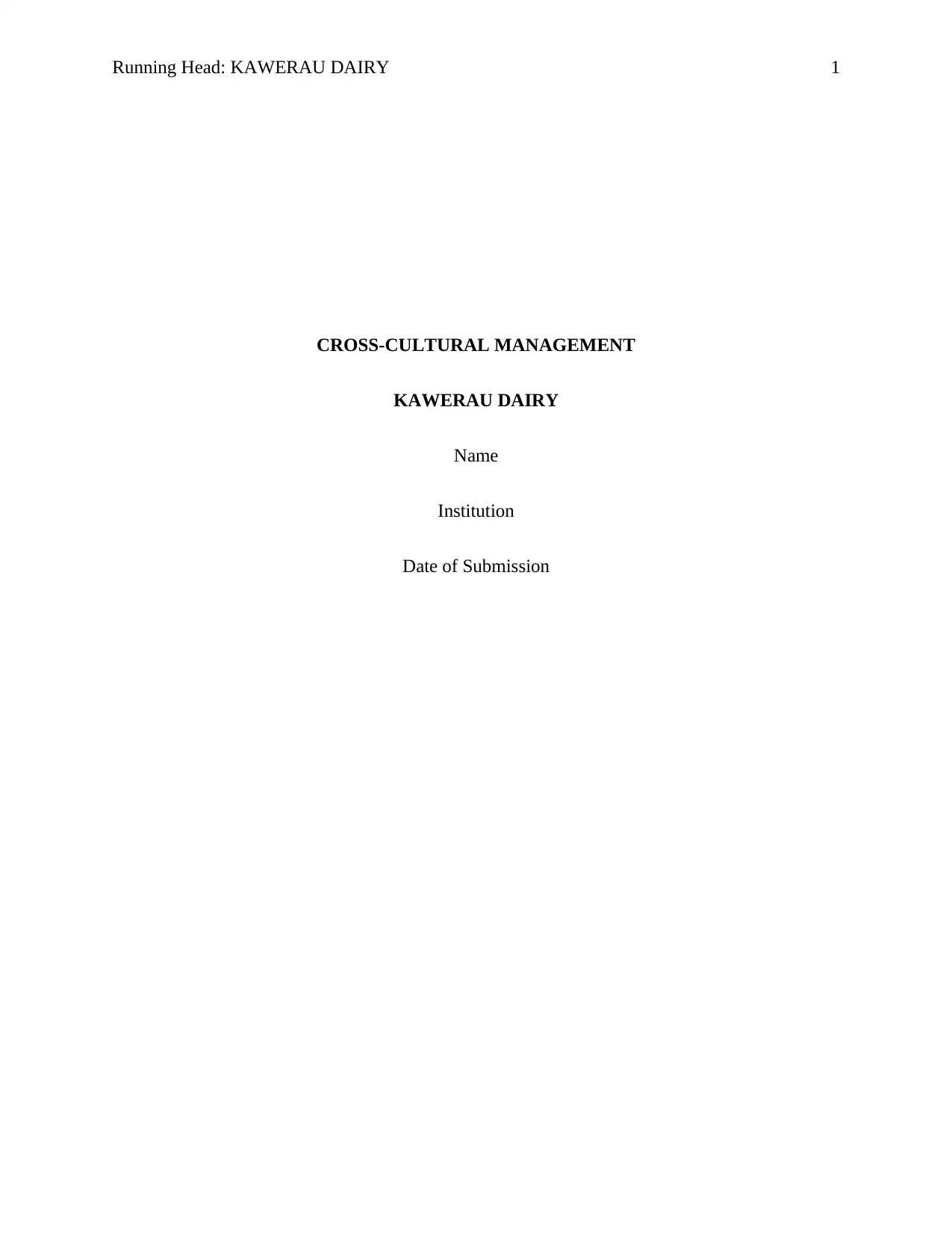
Running Head: KAWERAU DAIRY 1
CROSS-CULTURAL MANAGEMENT
KAWERAU DAIRY
Name
Institution
Date of Submission
CROSS-CULTURAL MANAGEMENT
KAWERAU DAIRY
Name
Institution
Date of Submission
Paraphrase This Document
Need a fresh take? Get an instant paraphrase of this document with our AI Paraphraser
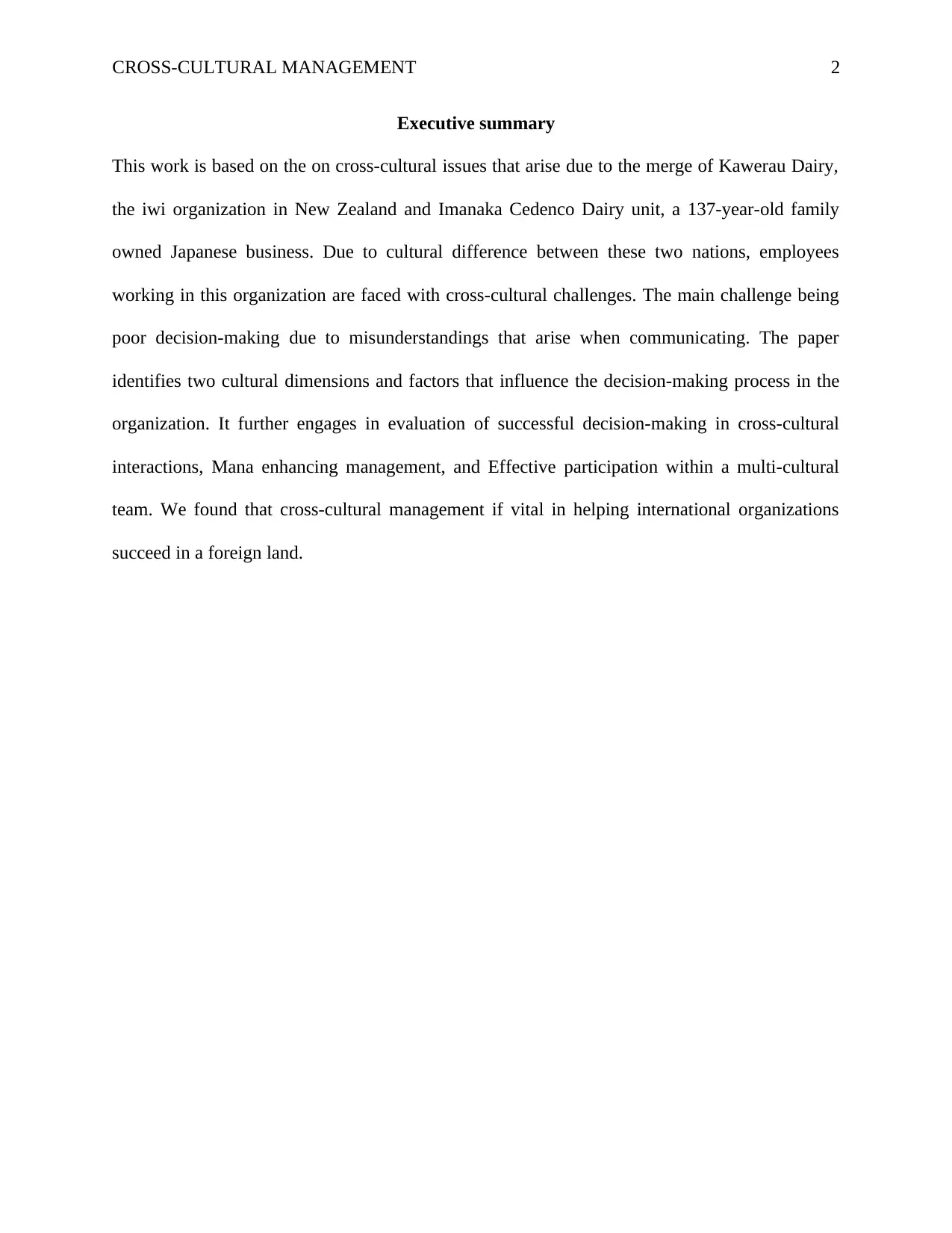
CROSS-CULTURAL MANAGEMENT 2
Executive summary
This work is based on the on cross-cultural issues that arise due to the merge of Kawerau Dairy,
the iwi organization in New Zealand and Imanaka Cedenco Dairy unit, a 137-year-old family
owned Japanese business. Due to cultural difference between these two nations, employees
working in this organization are faced with cross-cultural challenges. The main challenge being
poor decision-making due to misunderstandings that arise when communicating. The paper
identifies two cultural dimensions and factors that influence the decision-making process in the
organization. It further engages in evaluation of successful decision-making in cross-cultural
interactions, Mana enhancing management, and Effective participation within a multi-cultural
team. We found that cross-cultural management if vital in helping international organizations
succeed in a foreign land.
Executive summary
This work is based on the on cross-cultural issues that arise due to the merge of Kawerau Dairy,
the iwi organization in New Zealand and Imanaka Cedenco Dairy unit, a 137-year-old family
owned Japanese business. Due to cultural difference between these two nations, employees
working in this organization are faced with cross-cultural challenges. The main challenge being
poor decision-making due to misunderstandings that arise when communicating. The paper
identifies two cultural dimensions and factors that influence the decision-making process in the
organization. It further engages in evaluation of successful decision-making in cross-cultural
interactions, Mana enhancing management, and Effective participation within a multi-cultural
team. We found that cross-cultural management if vital in helping international organizations
succeed in a foreign land.
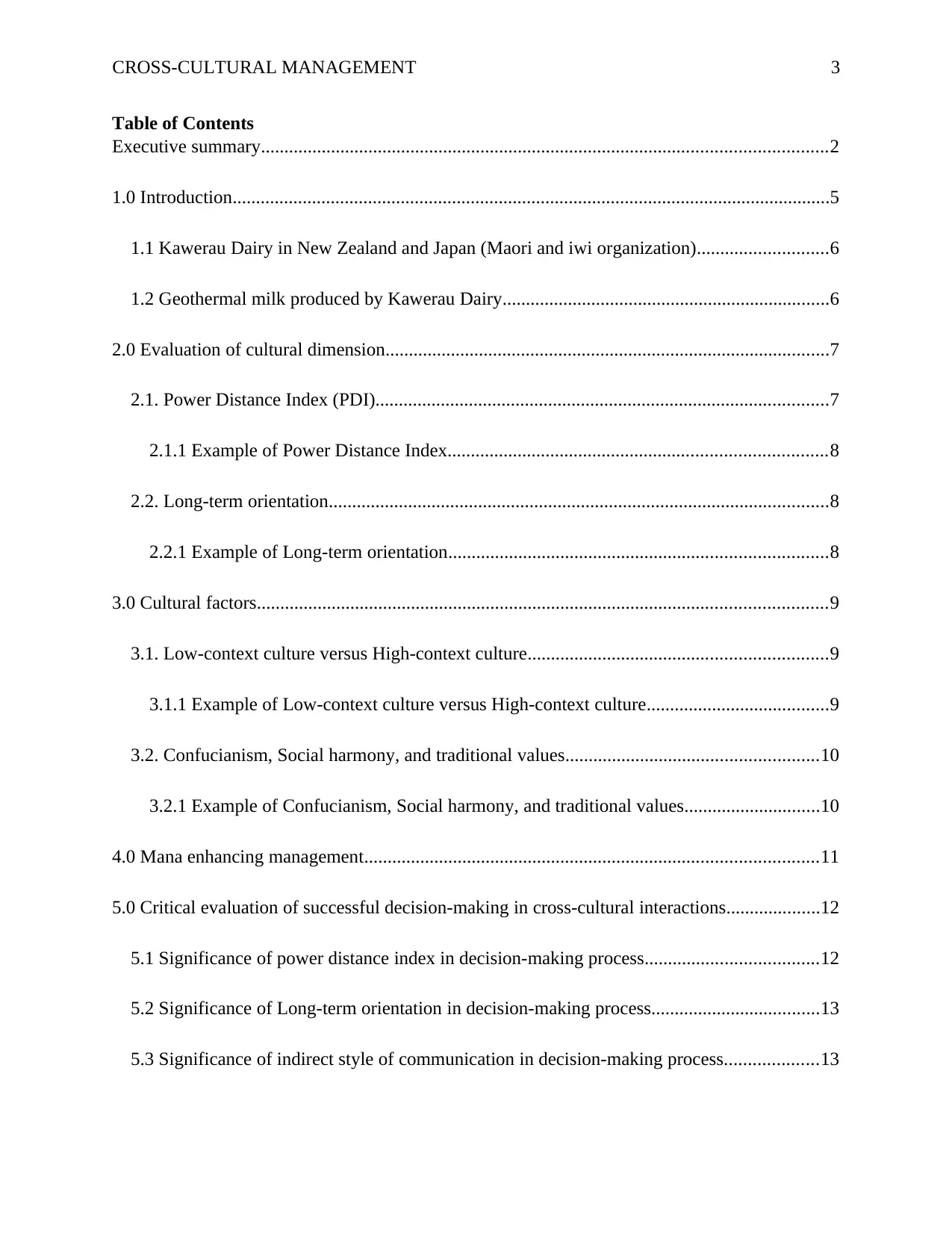
CROSS-CULTURAL MANAGEMENT 3
Table of Contents
Executive summary.........................................................................................................................2
1.0 Introduction................................................................................................................................5
1.1 Kawerau Dairy in New Zealand and Japan (Maori and iwi organization)............................6
1.2 Geothermal milk produced by Kawerau Dairy......................................................................6
2.0 Evaluation of cultural dimension...............................................................................................7
2.1. Power Distance Index (PDI).................................................................................................7
2.1.1 Example of Power Distance Index.................................................................................8
2.2. Long-term orientation...........................................................................................................8
2.2.1 Example of Long-term orientation.................................................................................8
3.0 Cultural factors..........................................................................................................................9
3.1. Low-context culture versus High-context culture................................................................9
3.1.1 Example of Low-context culture versus High-context culture.......................................9
3.2. Confucianism, Social harmony, and traditional values......................................................10
3.2.1 Example of Confucianism, Social harmony, and traditional values.............................10
4.0 Mana enhancing management.................................................................................................11
5.0 Critical evaluation of successful decision-making in cross-cultural interactions....................12
5.1 Significance of power distance index in decision-making process.....................................12
5.2 Significance of Long-term orientation in decision-making process....................................13
5.3 Significance of indirect style of communication in decision-making process....................13
Table of Contents
Executive summary.........................................................................................................................2
1.0 Introduction................................................................................................................................5
1.1 Kawerau Dairy in New Zealand and Japan (Maori and iwi organization)............................6
1.2 Geothermal milk produced by Kawerau Dairy......................................................................6
2.0 Evaluation of cultural dimension...............................................................................................7
2.1. Power Distance Index (PDI).................................................................................................7
2.1.1 Example of Power Distance Index.................................................................................8
2.2. Long-term orientation...........................................................................................................8
2.2.1 Example of Long-term orientation.................................................................................8
3.0 Cultural factors..........................................................................................................................9
3.1. Low-context culture versus High-context culture................................................................9
3.1.1 Example of Low-context culture versus High-context culture.......................................9
3.2. Confucianism, Social harmony, and traditional values......................................................10
3.2.1 Example of Confucianism, Social harmony, and traditional values.............................10
4.0 Mana enhancing management.................................................................................................11
5.0 Critical evaluation of successful decision-making in cross-cultural interactions....................12
5.1 Significance of power distance index in decision-making process.....................................12
5.2 Significance of Long-term orientation in decision-making process....................................13
5.3 Significance of indirect style of communication in decision-making process....................13
⊘ This is a preview!⊘
Do you want full access?
Subscribe today to unlock all pages.

Trusted by 1+ million students worldwide
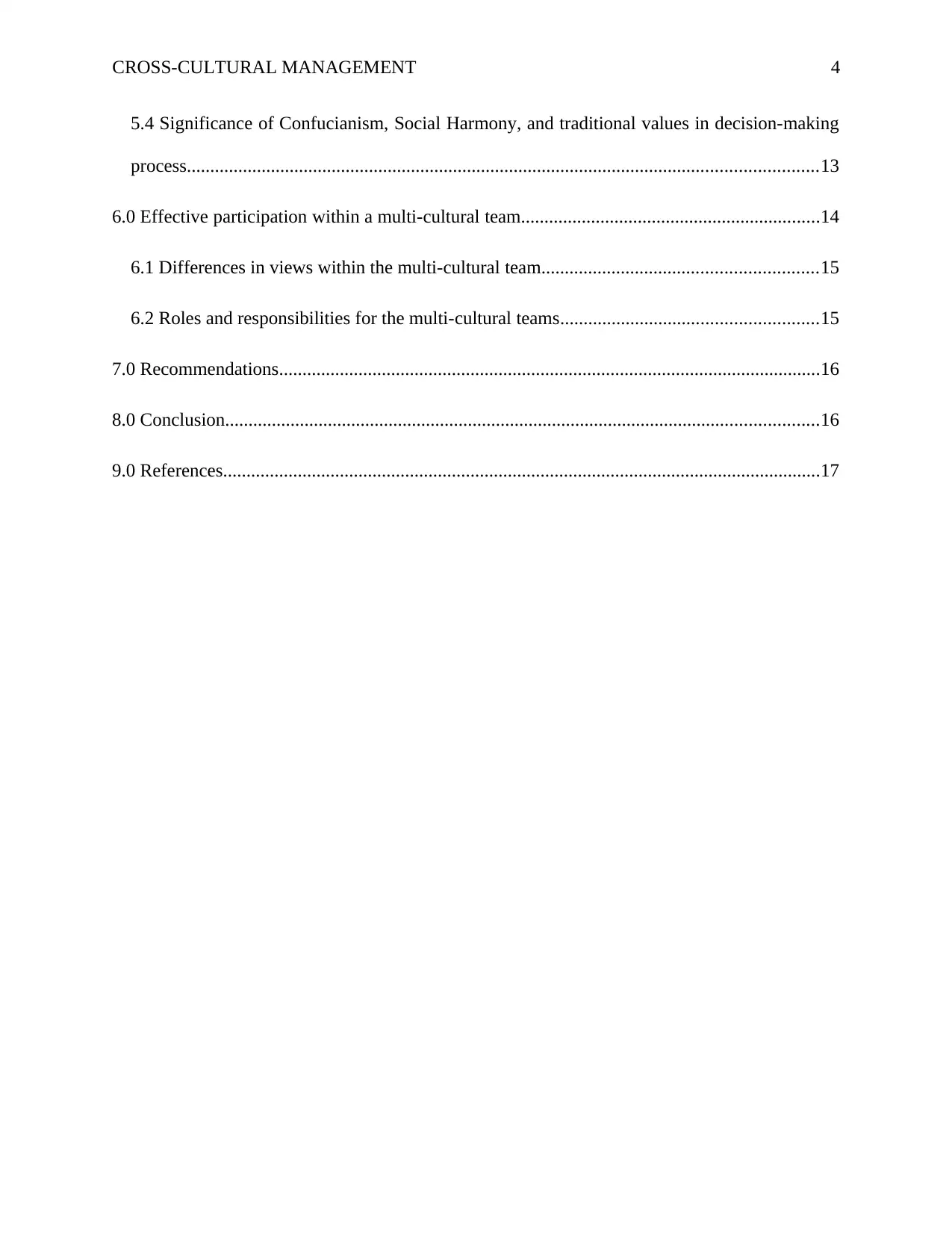
CROSS-CULTURAL MANAGEMENT 4
5.4 Significance of Confucianism, Social Harmony, and traditional values in decision-making
process.......................................................................................................................................13
6.0 Effective participation within a multi-cultural team................................................................14
6.1 Differences in views within the multi-cultural team...........................................................15
6.2 Roles and responsibilities for the multi-cultural teams.......................................................15
7.0 Recommendations....................................................................................................................16
8.0 Conclusion...............................................................................................................................16
9.0 References................................................................................................................................17
5.4 Significance of Confucianism, Social Harmony, and traditional values in decision-making
process.......................................................................................................................................13
6.0 Effective participation within a multi-cultural team................................................................14
6.1 Differences in views within the multi-cultural team...........................................................15
6.2 Roles and responsibilities for the multi-cultural teams.......................................................15
7.0 Recommendations....................................................................................................................16
8.0 Conclusion...............................................................................................................................16
9.0 References................................................................................................................................17
Paraphrase This Document
Need a fresh take? Get an instant paraphrase of this document with our AI Paraphraser
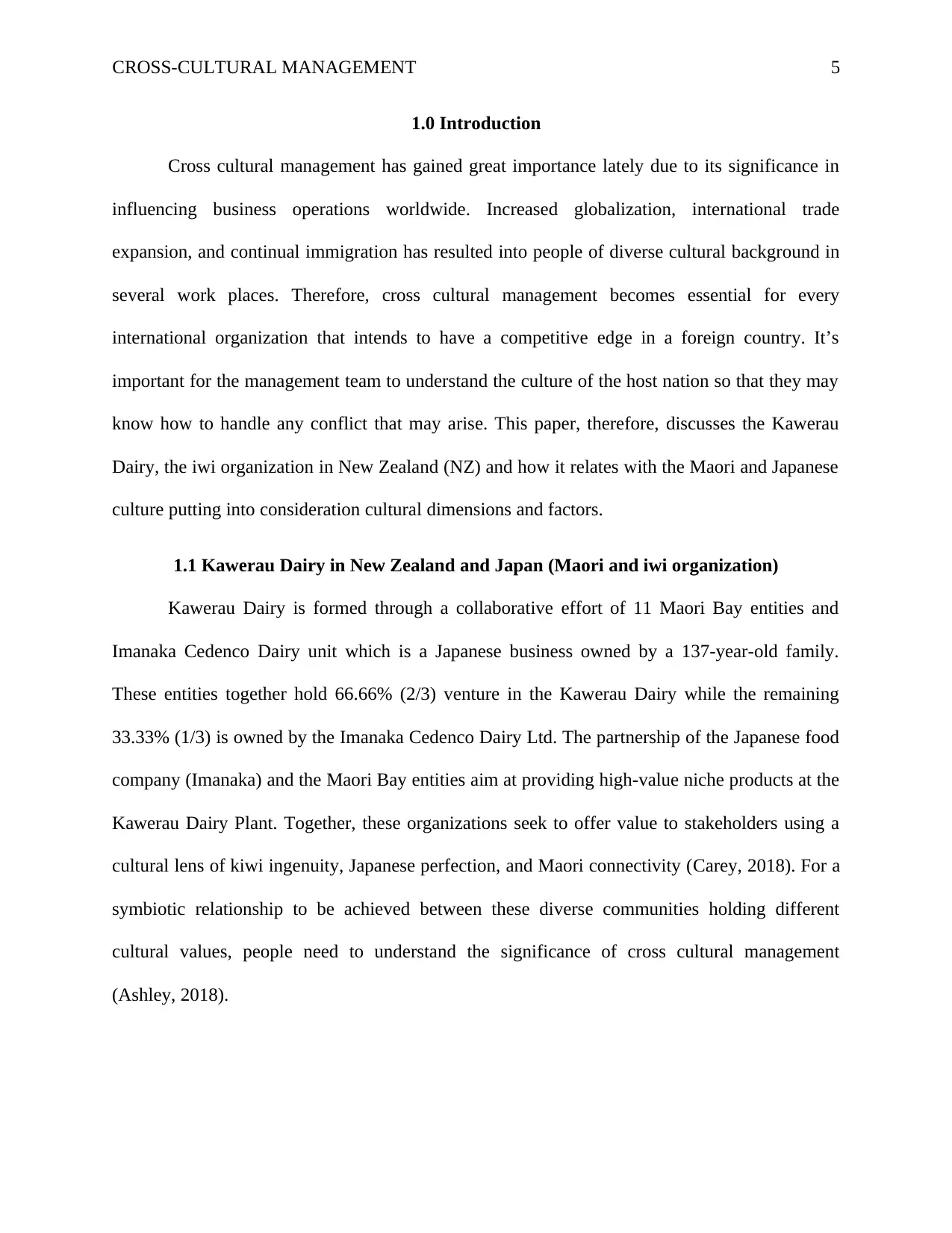
CROSS-CULTURAL MANAGEMENT 5
1.0 Introduction
Cross cultural management has gained great importance lately due to its significance in
influencing business operations worldwide. Increased globalization, international trade
expansion, and continual immigration has resulted into people of diverse cultural background in
several work places. Therefore, cross cultural management becomes essential for every
international organization that intends to have a competitive edge in a foreign country. It’s
important for the management team to understand the culture of the host nation so that they may
know how to handle any conflict that may arise. This paper, therefore, discusses the Kawerau
Dairy, the iwi organization in New Zealand (NZ) and how it relates with the Maori and Japanese
culture putting into consideration cultural dimensions and factors.
1.1 Kawerau Dairy in New Zealand and Japan (Maori and iwi organization)
Kawerau Dairy is formed through a collaborative effort of 11 Maori Bay entities and
Imanaka Cedenco Dairy unit which is a Japanese business owned by a 137-year-old family.
These entities together hold 66.66% (2/3) venture in the Kawerau Dairy while the remaining
33.33% (1/3) is owned by the Imanaka Cedenco Dairy Ltd. The partnership of the Japanese food
company (Imanaka) and the Maori Bay entities aim at providing high-value niche products at the
Kawerau Dairy Plant. Together, these organizations seek to offer value to stakeholders using a
cultural lens of kiwi ingenuity, Japanese perfection, and Maori connectivity (Carey, 2018). For a
symbiotic relationship to be achieved between these diverse communities holding different
cultural values, people need to understand the significance of cross cultural management
(Ashley, 2018).
1.0 Introduction
Cross cultural management has gained great importance lately due to its significance in
influencing business operations worldwide. Increased globalization, international trade
expansion, and continual immigration has resulted into people of diverse cultural background in
several work places. Therefore, cross cultural management becomes essential for every
international organization that intends to have a competitive edge in a foreign country. It’s
important for the management team to understand the culture of the host nation so that they may
know how to handle any conflict that may arise. This paper, therefore, discusses the Kawerau
Dairy, the iwi organization in New Zealand (NZ) and how it relates with the Maori and Japanese
culture putting into consideration cultural dimensions and factors.
1.1 Kawerau Dairy in New Zealand and Japan (Maori and iwi organization)
Kawerau Dairy is formed through a collaborative effort of 11 Maori Bay entities and
Imanaka Cedenco Dairy unit which is a Japanese business owned by a 137-year-old family.
These entities together hold 66.66% (2/3) venture in the Kawerau Dairy while the remaining
33.33% (1/3) is owned by the Imanaka Cedenco Dairy Ltd. The partnership of the Japanese food
company (Imanaka) and the Maori Bay entities aim at providing high-value niche products at the
Kawerau Dairy Plant. Together, these organizations seek to offer value to stakeholders using a
cultural lens of kiwi ingenuity, Japanese perfection, and Maori connectivity (Carey, 2018). For a
symbiotic relationship to be achieved between these diverse communities holding different
cultural values, people need to understand the significance of cross cultural management
(Ashley, 2018).
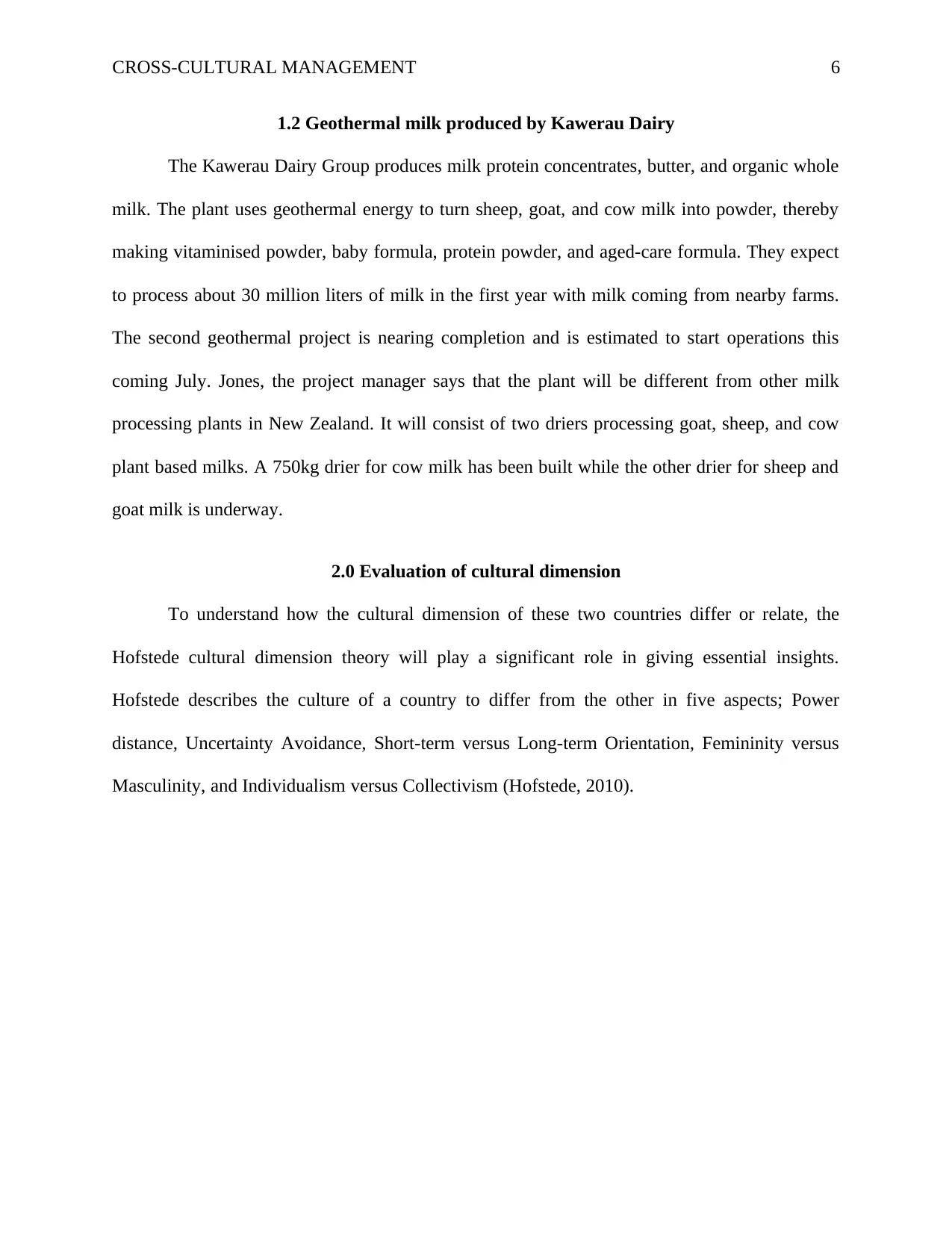
CROSS-CULTURAL MANAGEMENT 6
1.2 Geothermal milk produced by Kawerau Dairy
The Kawerau Dairy Group produces milk protein concentrates, butter, and organic whole
milk. The plant uses geothermal energy to turn sheep, goat, and cow milk into powder, thereby
making vitaminised powder, baby formula, protein powder, and aged-care formula. They expect
to process about 30 million liters of milk in the first year with milk coming from nearby farms.
The second geothermal project is nearing completion and is estimated to start operations this
coming July. Jones, the project manager says that the plant will be different from other milk
processing plants in New Zealand. It will consist of two driers processing goat, sheep, and cow
plant based milks. A 750kg drier for cow milk has been built while the other drier for sheep and
goat milk is underway.
2.0 Evaluation of cultural dimension
To understand how the cultural dimension of these two countries differ or relate, the
Hofstede cultural dimension theory will play a significant role in giving essential insights.
Hofstede describes the culture of a country to differ from the other in five aspects; Power
distance, Uncertainty Avoidance, Short-term versus Long-term Orientation, Femininity versus
Masculinity, and Individualism versus Collectivism (Hofstede, 2010).
1.2 Geothermal milk produced by Kawerau Dairy
The Kawerau Dairy Group produces milk protein concentrates, butter, and organic whole
milk. The plant uses geothermal energy to turn sheep, goat, and cow milk into powder, thereby
making vitaminised powder, baby formula, protein powder, and aged-care formula. They expect
to process about 30 million liters of milk in the first year with milk coming from nearby farms.
The second geothermal project is nearing completion and is estimated to start operations this
coming July. Jones, the project manager says that the plant will be different from other milk
processing plants in New Zealand. It will consist of two driers processing goat, sheep, and cow
plant based milks. A 750kg drier for cow milk has been built while the other drier for sheep and
goat milk is underway.
2.0 Evaluation of cultural dimension
To understand how the cultural dimension of these two countries differ or relate, the
Hofstede cultural dimension theory will play a significant role in giving essential insights.
Hofstede describes the culture of a country to differ from the other in five aspects; Power
distance, Uncertainty Avoidance, Short-term versus Long-term Orientation, Femininity versus
Masculinity, and Individualism versus Collectivism (Hofstede, 2010).
⊘ This is a preview!⊘
Do you want full access?
Subscribe today to unlock all pages.

Trusted by 1+ million students worldwide
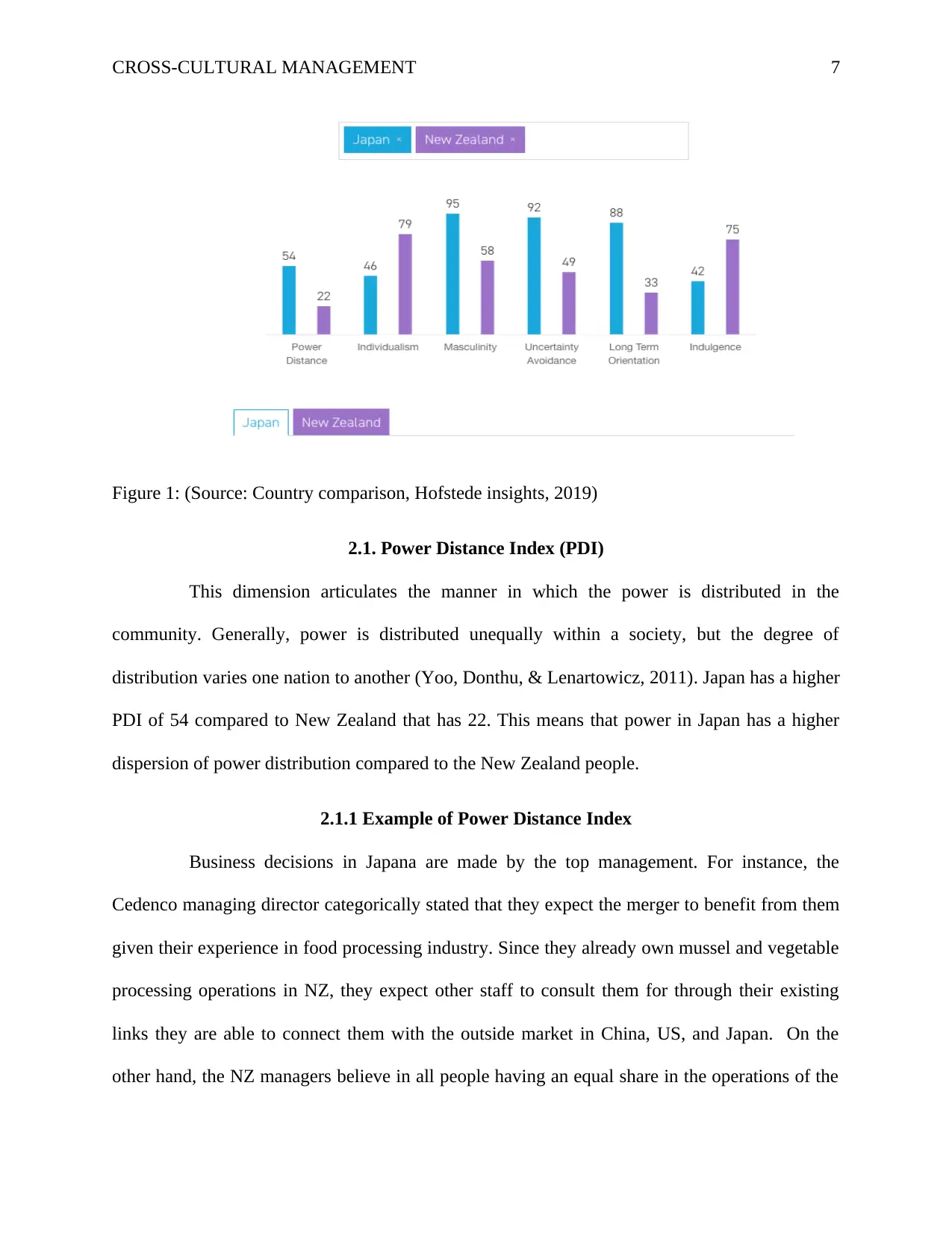
CROSS-CULTURAL MANAGEMENT 7
Figure 1: (Source: Country comparison, Hofstede insights, 2019)
2.1. Power Distance Index (PDI)
This dimension articulates the manner in which the power is distributed in the
community. Generally, power is distributed unequally within a society, but the degree of
distribution varies one nation to another (Yoo, Donthu, & Lenartowicz, 2011). Japan has a higher
PDI of 54 compared to New Zealand that has 22. This means that power in Japan has a higher
dispersion of power distribution compared to the New Zealand people.
2.1.1 Example of Power Distance Index
Business decisions in Japana are made by the top management. For instance, the
Cedenco managing director categorically stated that they expect the merger to benefit from them
given their experience in food processing industry. Since they already own mussel and vegetable
processing operations in NZ, they expect other staff to consult them for through their existing
links they are able to connect them with the outside market in China, US, and Japan. On the
other hand, the NZ managers believe in all people having an equal share in the operations of the
Figure 1: (Source: Country comparison, Hofstede insights, 2019)
2.1. Power Distance Index (PDI)
This dimension articulates the manner in which the power is distributed in the
community. Generally, power is distributed unequally within a society, but the degree of
distribution varies one nation to another (Yoo, Donthu, & Lenartowicz, 2011). Japan has a higher
PDI of 54 compared to New Zealand that has 22. This means that power in Japan has a higher
dispersion of power distribution compared to the New Zealand people.
2.1.1 Example of Power Distance Index
Business decisions in Japana are made by the top management. For instance, the
Cedenco managing director categorically stated that they expect the merger to benefit from them
given their experience in food processing industry. Since they already own mussel and vegetable
processing operations in NZ, they expect other staff to consult them for through their existing
links they are able to connect them with the outside market in China, US, and Japan. On the
other hand, the NZ managers believe in all people having an equal share in the operations of the
Paraphrase This Document
Need a fresh take? Get an instant paraphrase of this document with our AI Paraphraser
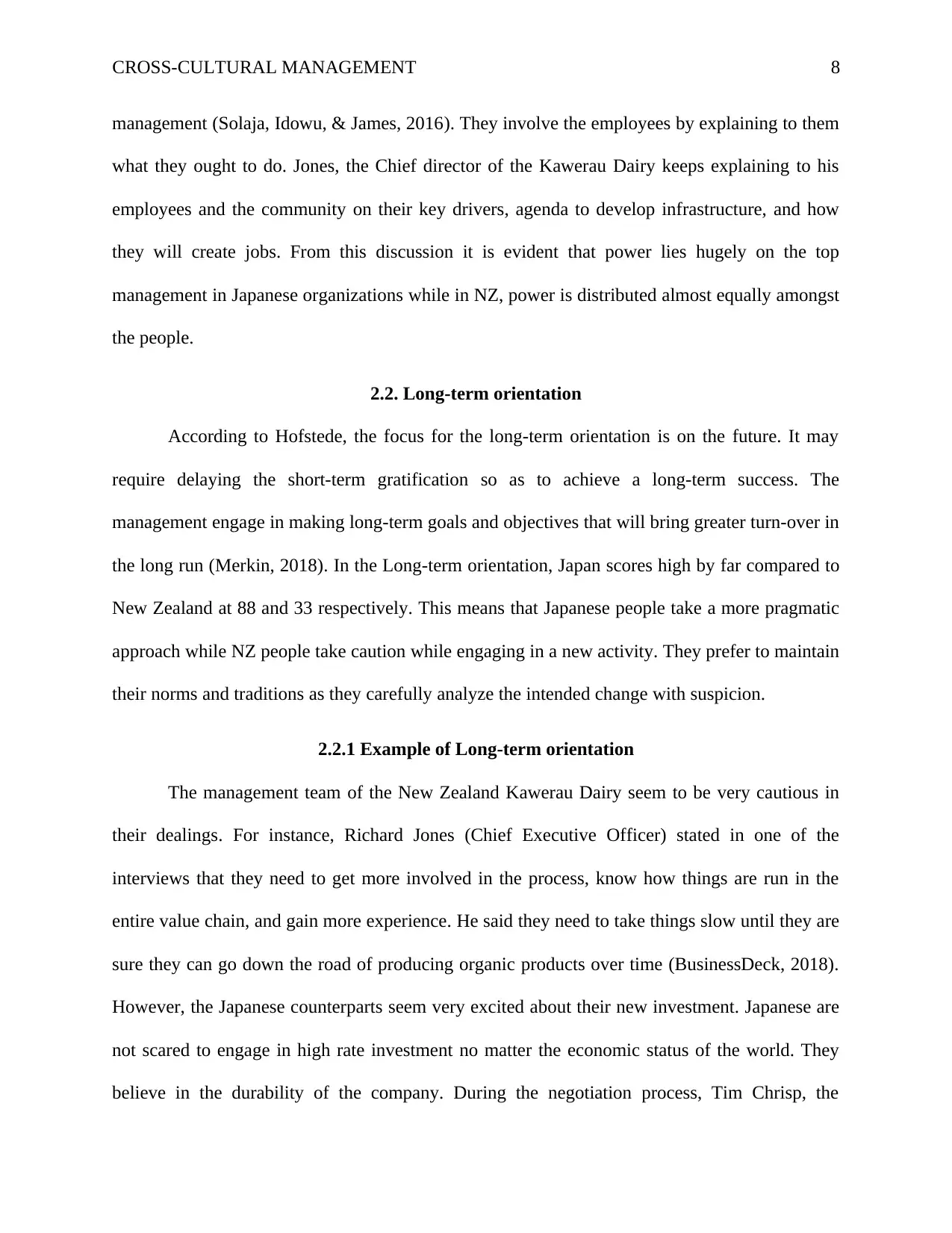
CROSS-CULTURAL MANAGEMENT 8
management (Solaja, Idowu, & James, 2016). They involve the employees by explaining to them
what they ought to do. Jones, the Chief director of the Kawerau Dairy keeps explaining to his
employees and the community on their key drivers, agenda to develop infrastructure, and how
they will create jobs. From this discussion it is evident that power lies hugely on the top
management in Japanese organizations while in NZ, power is distributed almost equally amongst
the people.
2.2. Long-term orientation
According to Hofstede, the focus for the long-term orientation is on the future. It may
require delaying the short-term gratification so as to achieve a long-term success. The
management engage in making long-term goals and objectives that will bring greater turn-over in
the long run (Merkin, 2018). In the Long-term orientation, Japan scores high by far compared to
New Zealand at 88 and 33 respectively. This means that Japanese people take a more pragmatic
approach while NZ people take caution while engaging in a new activity. They prefer to maintain
their norms and traditions as they carefully analyze the intended change with suspicion.
2.2.1 Example of Long-term orientation
The management team of the New Zealand Kawerau Dairy seem to be very cautious in
their dealings. For instance, Richard Jones (Chief Executive Officer) stated in one of the
interviews that they need to get more involved in the process, know how things are run in the
entire value chain, and gain more experience. He said they need to take things slow until they are
sure they can go down the road of producing organic products over time (BusinessDeck, 2018).
However, the Japanese counterparts seem very excited about their new investment. Japanese are
not scared to engage in high rate investment no matter the economic status of the world. They
believe in the durability of the company. During the negotiation process, Tim Chrisp, the
management (Solaja, Idowu, & James, 2016). They involve the employees by explaining to them
what they ought to do. Jones, the Chief director of the Kawerau Dairy keeps explaining to his
employees and the community on their key drivers, agenda to develop infrastructure, and how
they will create jobs. From this discussion it is evident that power lies hugely on the top
management in Japanese organizations while in NZ, power is distributed almost equally amongst
the people.
2.2. Long-term orientation
According to Hofstede, the focus for the long-term orientation is on the future. It may
require delaying the short-term gratification so as to achieve a long-term success. The
management engage in making long-term goals and objectives that will bring greater turn-over in
the long run (Merkin, 2018). In the Long-term orientation, Japan scores high by far compared to
New Zealand at 88 and 33 respectively. This means that Japanese people take a more pragmatic
approach while NZ people take caution while engaging in a new activity. They prefer to maintain
their norms and traditions as they carefully analyze the intended change with suspicion.
2.2.1 Example of Long-term orientation
The management team of the New Zealand Kawerau Dairy seem to be very cautious in
their dealings. For instance, Richard Jones (Chief Executive Officer) stated in one of the
interviews that they need to get more involved in the process, know how things are run in the
entire value chain, and gain more experience. He said they need to take things slow until they are
sure they can go down the road of producing organic products over time (BusinessDeck, 2018).
However, the Japanese counterparts seem very excited about their new investment. Japanese are
not scared to engage in high rate investment no matter the economic status of the world. They
believe in the durability of the company. During the negotiation process, Tim Chrisp, the
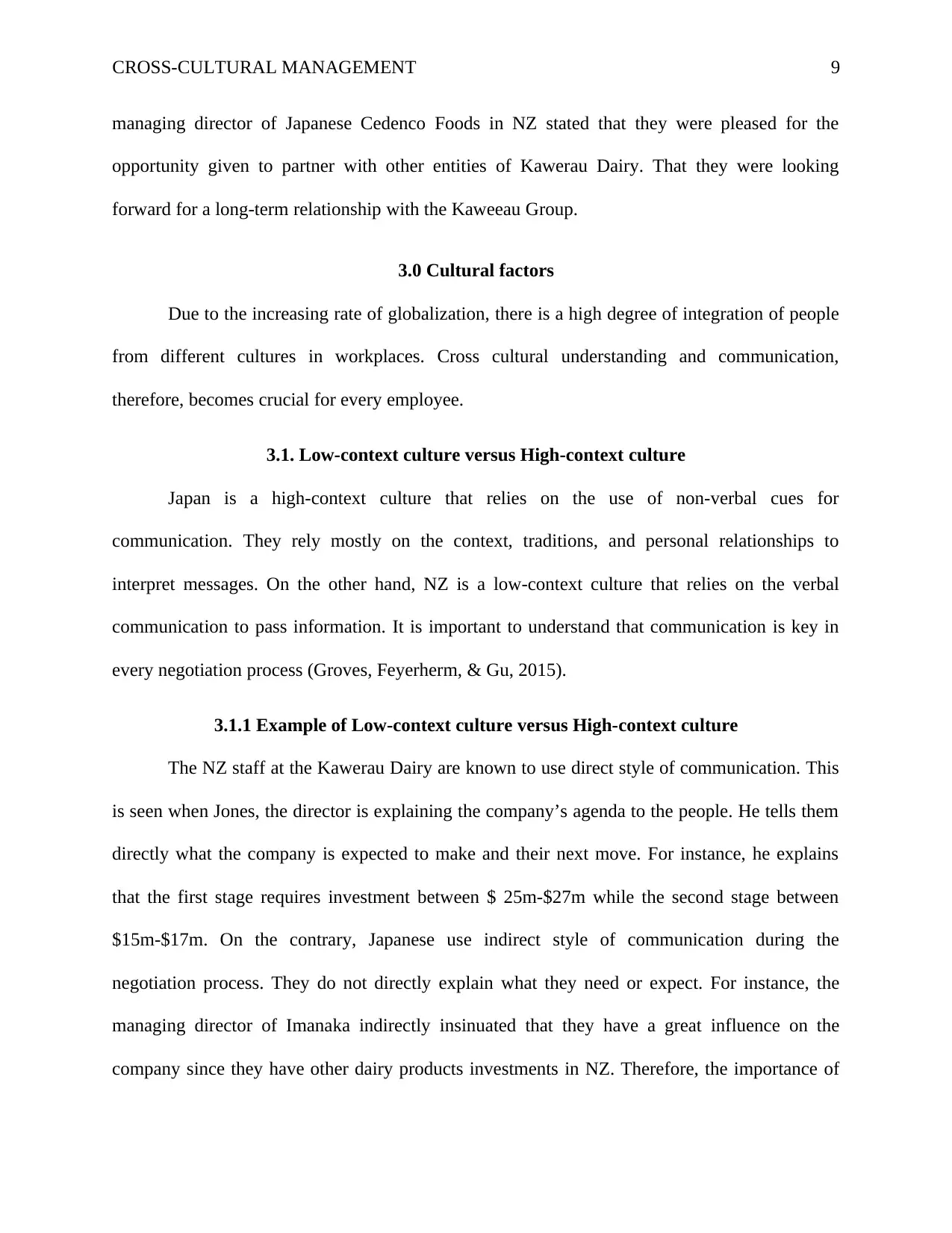
CROSS-CULTURAL MANAGEMENT 9
managing director of Japanese Cedenco Foods in NZ stated that they were pleased for the
opportunity given to partner with other entities of Kawerau Dairy. That they were looking
forward for a long-term relationship with the Kaweeau Group.
3.0 Cultural factors
Due to the increasing rate of globalization, there is a high degree of integration of people
from different cultures in workplaces. Cross cultural understanding and communication,
therefore, becomes crucial for every employee.
3.1. Low-context culture versus High-context culture
Japan is a high-context culture that relies on the use of non-verbal cues for
communication. They rely mostly on the context, traditions, and personal relationships to
interpret messages. On the other hand, NZ is a low-context culture that relies on the verbal
communication to pass information. It is important to understand that communication is key in
every negotiation process (Groves, Feyerherm, & Gu, 2015).
3.1.1 Example of Low-context culture versus High-context culture
The NZ staff at the Kawerau Dairy are known to use direct style of communication. This
is seen when Jones, the director is explaining the company’s agenda to the people. He tells them
directly what the company is expected to make and their next move. For instance, he explains
that the first stage requires investment between $ 25m-$27m while the second stage between
$15m-$17m. On the contrary, Japanese use indirect style of communication during the
negotiation process. They do not directly explain what they need or expect. For instance, the
managing director of Imanaka indirectly insinuated that they have a great influence on the
company since they have other dairy products investments in NZ. Therefore, the importance of
managing director of Japanese Cedenco Foods in NZ stated that they were pleased for the
opportunity given to partner with other entities of Kawerau Dairy. That they were looking
forward for a long-term relationship with the Kaweeau Group.
3.0 Cultural factors
Due to the increasing rate of globalization, there is a high degree of integration of people
from different cultures in workplaces. Cross cultural understanding and communication,
therefore, becomes crucial for every employee.
3.1. Low-context culture versus High-context culture
Japan is a high-context culture that relies on the use of non-verbal cues for
communication. They rely mostly on the context, traditions, and personal relationships to
interpret messages. On the other hand, NZ is a low-context culture that relies on the verbal
communication to pass information. It is important to understand that communication is key in
every negotiation process (Groves, Feyerherm, & Gu, 2015).
3.1.1 Example of Low-context culture versus High-context culture
The NZ staff at the Kawerau Dairy are known to use direct style of communication. This
is seen when Jones, the director is explaining the company’s agenda to the people. He tells them
directly what the company is expected to make and their next move. For instance, he explains
that the first stage requires investment between $ 25m-$27m while the second stage between
$15m-$17m. On the contrary, Japanese use indirect style of communication during the
negotiation process. They do not directly explain what they need or expect. For instance, the
managing director of Imanaka indirectly insinuated that they have a great influence on the
company since they have other dairy products investments in NZ. Therefore, the importance of
⊘ This is a preview!⊘
Do you want full access?
Subscribe today to unlock all pages.

Trusted by 1+ million students worldwide
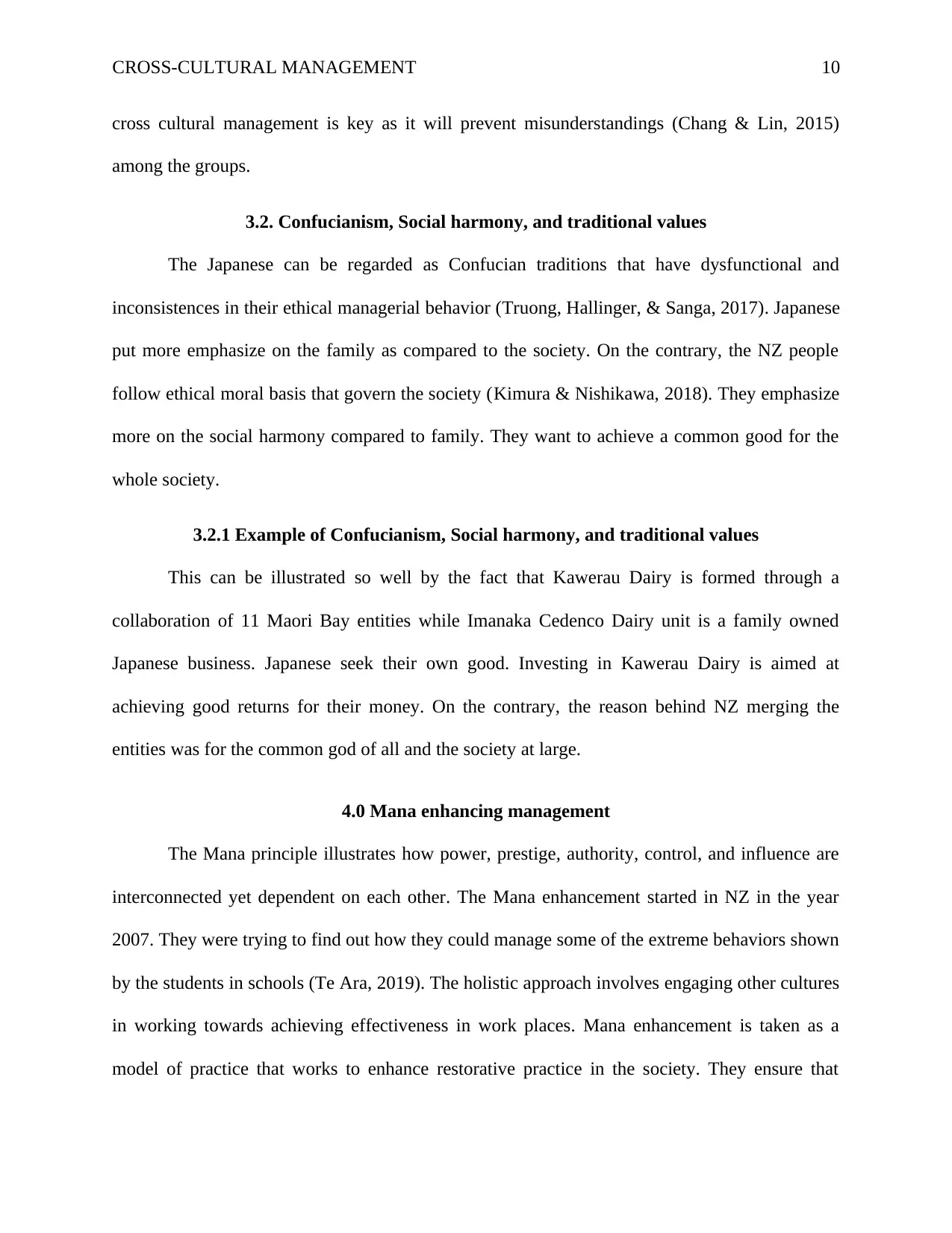
CROSS-CULTURAL MANAGEMENT 10
cross cultural management is key as it will prevent misunderstandings (Chang & Lin, 2015)
among the groups.
3.2. Confucianism, Social harmony, and traditional values
The Japanese can be regarded as Confucian traditions that have dysfunctional and
inconsistences in their ethical managerial behavior (Truong, Hallinger, & Sanga, 2017). Japanese
put more emphasize on the family as compared to the society. On the contrary, the NZ people
follow ethical moral basis that govern the society (Kimura & Nishikawa, 2018). They emphasize
more on the social harmony compared to family. They want to achieve a common good for the
whole society.
3.2.1 Example of Confucianism, Social harmony, and traditional values
This can be illustrated so well by the fact that Kawerau Dairy is formed through a
collaboration of 11 Maori Bay entities while Imanaka Cedenco Dairy unit is a family owned
Japanese business. Japanese seek their own good. Investing in Kawerau Dairy is aimed at
achieving good returns for their money. On the contrary, the reason behind NZ merging the
entities was for the common god of all and the society at large.
4.0 Mana enhancing management
The Mana principle illustrates how power, prestige, authority, control, and influence are
interconnected yet dependent on each other. The Mana enhancement started in NZ in the year
2007. They were trying to find out how they could manage some of the extreme behaviors shown
by the students in schools (Te Ara, 2019). The holistic approach involves engaging other cultures
in working towards achieving effectiveness in work places. Mana enhancement is taken as a
model of practice that works to enhance restorative practice in the society. They ensure that
cross cultural management is key as it will prevent misunderstandings (Chang & Lin, 2015)
among the groups.
3.2. Confucianism, Social harmony, and traditional values
The Japanese can be regarded as Confucian traditions that have dysfunctional and
inconsistences in their ethical managerial behavior (Truong, Hallinger, & Sanga, 2017). Japanese
put more emphasize on the family as compared to the society. On the contrary, the NZ people
follow ethical moral basis that govern the society (Kimura & Nishikawa, 2018). They emphasize
more on the social harmony compared to family. They want to achieve a common good for the
whole society.
3.2.1 Example of Confucianism, Social harmony, and traditional values
This can be illustrated so well by the fact that Kawerau Dairy is formed through a
collaboration of 11 Maori Bay entities while Imanaka Cedenco Dairy unit is a family owned
Japanese business. Japanese seek their own good. Investing in Kawerau Dairy is aimed at
achieving good returns for their money. On the contrary, the reason behind NZ merging the
entities was for the common god of all and the society at large.
4.0 Mana enhancing management
The Mana principle illustrates how power, prestige, authority, control, and influence are
interconnected yet dependent on each other. The Mana enhancement started in NZ in the year
2007. They were trying to find out how they could manage some of the extreme behaviors shown
by the students in schools (Te Ara, 2019). The holistic approach involves engaging other cultures
in working towards achieving effectiveness in work places. Mana enhancement is taken as a
model of practice that works to enhance restorative practice in the society. They ensure that
Paraphrase This Document
Need a fresh take? Get an instant paraphrase of this document with our AI Paraphraser
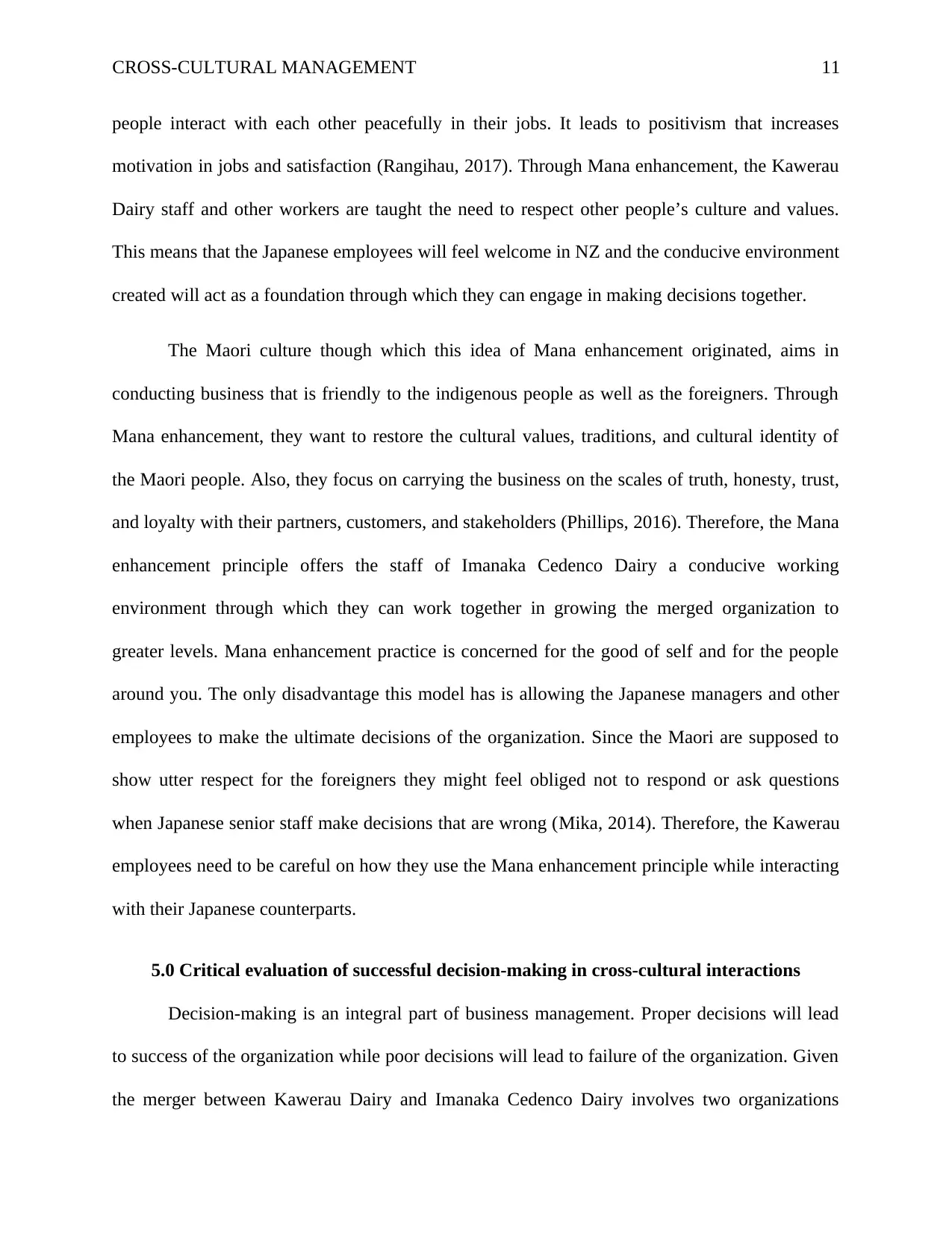
CROSS-CULTURAL MANAGEMENT 11
people interact with each other peacefully in their jobs. It leads to positivism that increases
motivation in jobs and satisfaction (Rangihau, 2017). Through Mana enhancement, the Kawerau
Dairy staff and other workers are taught the need to respect other people’s culture and values.
This means that the Japanese employees will feel welcome in NZ and the conducive environment
created will act as a foundation through which they can engage in making decisions together.
The Maori culture though which this idea of Mana enhancement originated, aims in
conducting business that is friendly to the indigenous people as well as the foreigners. Through
Mana enhancement, they want to restore the cultural values, traditions, and cultural identity of
the Maori people. Also, they focus on carrying the business on the scales of truth, honesty, trust,
and loyalty with their partners, customers, and stakeholders (Phillips, 2016). Therefore, the Mana
enhancement principle offers the staff of Imanaka Cedenco Dairy a conducive working
environment through which they can work together in growing the merged organization to
greater levels. Mana enhancement practice is concerned for the good of self and for the people
around you. The only disadvantage this model has is allowing the Japanese managers and other
employees to make the ultimate decisions of the organization. Since the Maori are supposed to
show utter respect for the foreigners they might feel obliged not to respond or ask questions
when Japanese senior staff make decisions that are wrong (Mika, 2014). Therefore, the Kawerau
employees need to be careful on how they use the Mana enhancement principle while interacting
with their Japanese counterparts.
5.0 Critical evaluation of successful decision-making in cross-cultural interactions
Decision-making is an integral part of business management. Proper decisions will lead
to success of the organization while poor decisions will lead to failure of the organization. Given
the merger between Kawerau Dairy and Imanaka Cedenco Dairy involves two organizations
people interact with each other peacefully in their jobs. It leads to positivism that increases
motivation in jobs and satisfaction (Rangihau, 2017). Through Mana enhancement, the Kawerau
Dairy staff and other workers are taught the need to respect other people’s culture and values.
This means that the Japanese employees will feel welcome in NZ and the conducive environment
created will act as a foundation through which they can engage in making decisions together.
The Maori culture though which this idea of Mana enhancement originated, aims in
conducting business that is friendly to the indigenous people as well as the foreigners. Through
Mana enhancement, they want to restore the cultural values, traditions, and cultural identity of
the Maori people. Also, they focus on carrying the business on the scales of truth, honesty, trust,
and loyalty with their partners, customers, and stakeholders (Phillips, 2016). Therefore, the Mana
enhancement principle offers the staff of Imanaka Cedenco Dairy a conducive working
environment through which they can work together in growing the merged organization to
greater levels. Mana enhancement practice is concerned for the good of self and for the people
around you. The only disadvantage this model has is allowing the Japanese managers and other
employees to make the ultimate decisions of the organization. Since the Maori are supposed to
show utter respect for the foreigners they might feel obliged not to respond or ask questions
when Japanese senior staff make decisions that are wrong (Mika, 2014). Therefore, the Kawerau
employees need to be careful on how they use the Mana enhancement principle while interacting
with their Japanese counterparts.
5.0 Critical evaluation of successful decision-making in cross-cultural interactions
Decision-making is an integral part of business management. Proper decisions will lead
to success of the organization while poor decisions will lead to failure of the organization. Given
the merger between Kawerau Dairy and Imanaka Cedenco Dairy involves two organizations
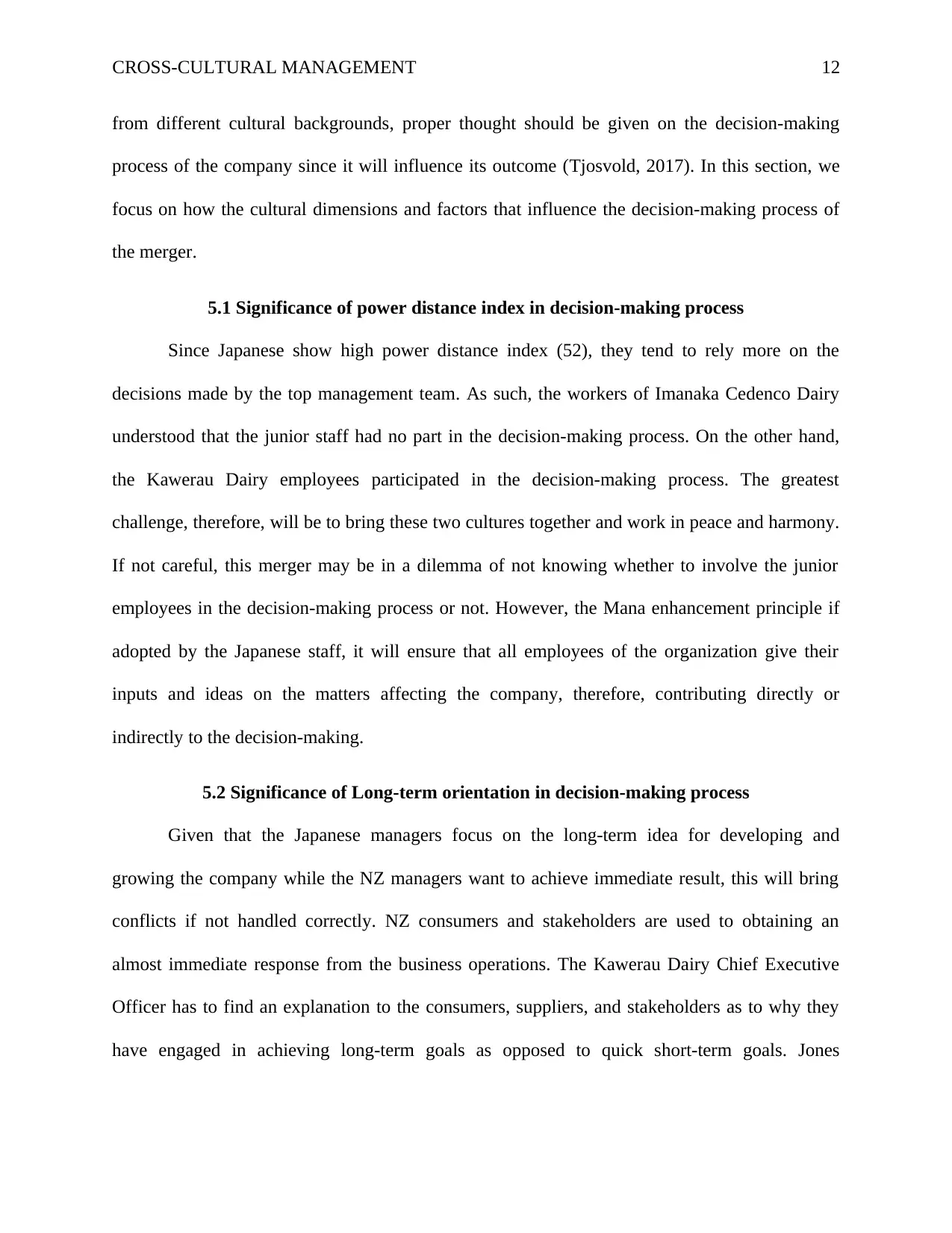
CROSS-CULTURAL MANAGEMENT 12
from different cultural backgrounds, proper thought should be given on the decision-making
process of the company since it will influence its outcome (Tjosvold, 2017). In this section, we
focus on how the cultural dimensions and factors that influence the decision-making process of
the merger.
5.1 Significance of power distance index in decision-making process
Since Japanese show high power distance index (52), they tend to rely more on the
decisions made by the top management team. As such, the workers of Imanaka Cedenco Dairy
understood that the junior staff had no part in the decision-making process. On the other hand,
the Kawerau Dairy employees participated in the decision-making process. The greatest
challenge, therefore, will be to bring these two cultures together and work in peace and harmony.
If not careful, this merger may be in a dilemma of not knowing whether to involve the junior
employees in the decision-making process or not. However, the Mana enhancement principle if
adopted by the Japanese staff, it will ensure that all employees of the organization give their
inputs and ideas on the matters affecting the company, therefore, contributing directly or
indirectly to the decision-making.
5.2 Significance of Long-term orientation in decision-making process
Given that the Japanese managers focus on the long-term idea for developing and
growing the company while the NZ managers want to achieve immediate result, this will bring
conflicts if not handled correctly. NZ consumers and stakeholders are used to obtaining an
almost immediate response from the business operations. The Kawerau Dairy Chief Executive
Officer has to find an explanation to the consumers, suppliers, and stakeholders as to why they
have engaged in achieving long-term goals as opposed to quick short-term goals. Jones
from different cultural backgrounds, proper thought should be given on the decision-making
process of the company since it will influence its outcome (Tjosvold, 2017). In this section, we
focus on how the cultural dimensions and factors that influence the decision-making process of
the merger.
5.1 Significance of power distance index in decision-making process
Since Japanese show high power distance index (52), they tend to rely more on the
decisions made by the top management team. As such, the workers of Imanaka Cedenco Dairy
understood that the junior staff had no part in the decision-making process. On the other hand,
the Kawerau Dairy employees participated in the decision-making process. The greatest
challenge, therefore, will be to bring these two cultures together and work in peace and harmony.
If not careful, this merger may be in a dilemma of not knowing whether to involve the junior
employees in the decision-making process or not. However, the Mana enhancement principle if
adopted by the Japanese staff, it will ensure that all employees of the organization give their
inputs and ideas on the matters affecting the company, therefore, contributing directly or
indirectly to the decision-making.
5.2 Significance of Long-term orientation in decision-making process
Given that the Japanese managers focus on the long-term idea for developing and
growing the company while the NZ managers want to achieve immediate result, this will bring
conflicts if not handled correctly. NZ consumers and stakeholders are used to obtaining an
almost immediate response from the business operations. The Kawerau Dairy Chief Executive
Officer has to find an explanation to the consumers, suppliers, and stakeholders as to why they
have engaged in achieving long-term goals as opposed to quick short-term goals. Jones
⊘ This is a preview!⊘
Do you want full access?
Subscribe today to unlock all pages.

Trusted by 1+ million students worldwide
1 out of 20
Related Documents
Your All-in-One AI-Powered Toolkit for Academic Success.
+13062052269
info@desklib.com
Available 24*7 on WhatsApp / Email
![[object Object]](/_next/static/media/star-bottom.7253800d.svg)
Unlock your academic potential
Copyright © 2020–2025 A2Z Services. All Rights Reserved. Developed and managed by ZUCOL.




